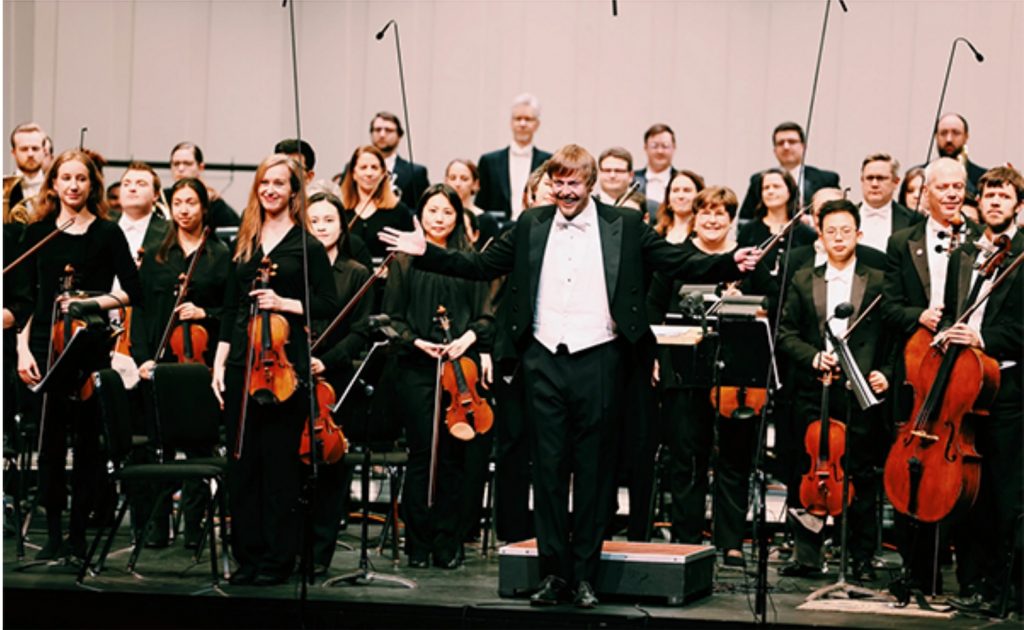by Kevin McLaughlin

Gaelicism is present, of course, in the symphony nicknames — Felix Mendelssohn’s “Scottish” and Amy Beach’s “Gaelic” — as well as their respective germs of inspiration: Mendelssohn’s almost mystical giddiness after a trip to the Scottish countryside (though not realized in music until over a decade later), and Beach’s methodical use of Irish tunes (added to her own) to create an original (and American) synthesis. More concoctions of mind than authenticities, perhaps, but still — what’s not to like?
What put it over may have been the last bit of showbiz. After returning to the stage for — we thought — one last bow, we saw that conductor Matthew Jenkins Jaroszewicz had donned a Scottish kilt under his tailcoat to lead the audience in a wee bit of singalong: Auld Lang Syne, half tribute to Robert Burns and half New Year’s benediction.
Mendelssohn visited Scotland in 1829 — famously walking through the ruins of Holyrood Chapel in Edinburgh, whose heavy atmosphere struck him as good source material for a symphony. Committing it to paper had to wait for over ten years, by which time memories of the trip must surely have faded. Even still, the “Scottish” Symphony went to press in 1842 with that nickname intact.
Jaroszewicz brought out the darker passions of the first movement — the Holyrood theme and the Allegro that follows. Maybe it was the dark-and-stormy weather outside (imported from the Highland moors for the occasion, no doubt), but a heavy weariness seemed to infiltrate the proceedings, in defiance of the “con moto” and “agitato” markings.
Proceeding without pause into the scherzo, as instructed by Mendelssohn, the orchestra quickly rallied. The Canton winds infused the big tune with plenty of upland spirit and kick. No actual bagpipes were harmed in the playing of this symphony, but you heard them in there just the same.
From there, conductor and orchestra luxuriated in the slow movement — one sounding more like German opera than Scottish balladeering — and got on with things for a direct and efficient finale.
Amy Beach’s powerful “Gaelic” Symphony, written in 1896, offers a vision of national identity in contrast to the model symphony supplied by Dvořák, “From the New World.” Beach’s debt to Dvořák is obvious in her use of the same key (E minor), oboe and English horn solos, and moments of idyllic charm. But while Dvořák’s symphony offers one idea of American authenticity — rooted to some degree in Native American and Black music — Beach’s looks to the British Isles.
The first movement is spun from her own Dark is the Night, a seafaring song describing a tempestuous journey accompanied by chromatic phrases. Jaroszewicz captained the orchestra over froth and foam as strings sailed ably on and hornist Mica Northam and trumpeter Larry Herman cast beams of light through the clouds.
Fine solo and ensemble moments also enriched the inner movements. In the “Alla siciliana,” Northam launched a soaring statement as preamble to the Allegro Vivace theme, played by oboist Terry Orcutt with countrified grace.
Concertmaster Konrad Kowal was spotlighted in the third movement in an extended cadenza, before cellist Mingyao Zhao joined him for a tender operatic duet. Jaroszewicz opened the throttle in the last movement — a march based not on folk melody but on musical cells heard earlier — for a vigorous and happy conclusion.
Published on ClevelandClassical.com January 30, 2024.
Click here for a printable copy of this article



